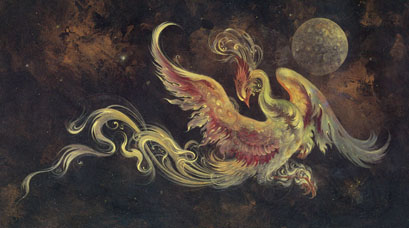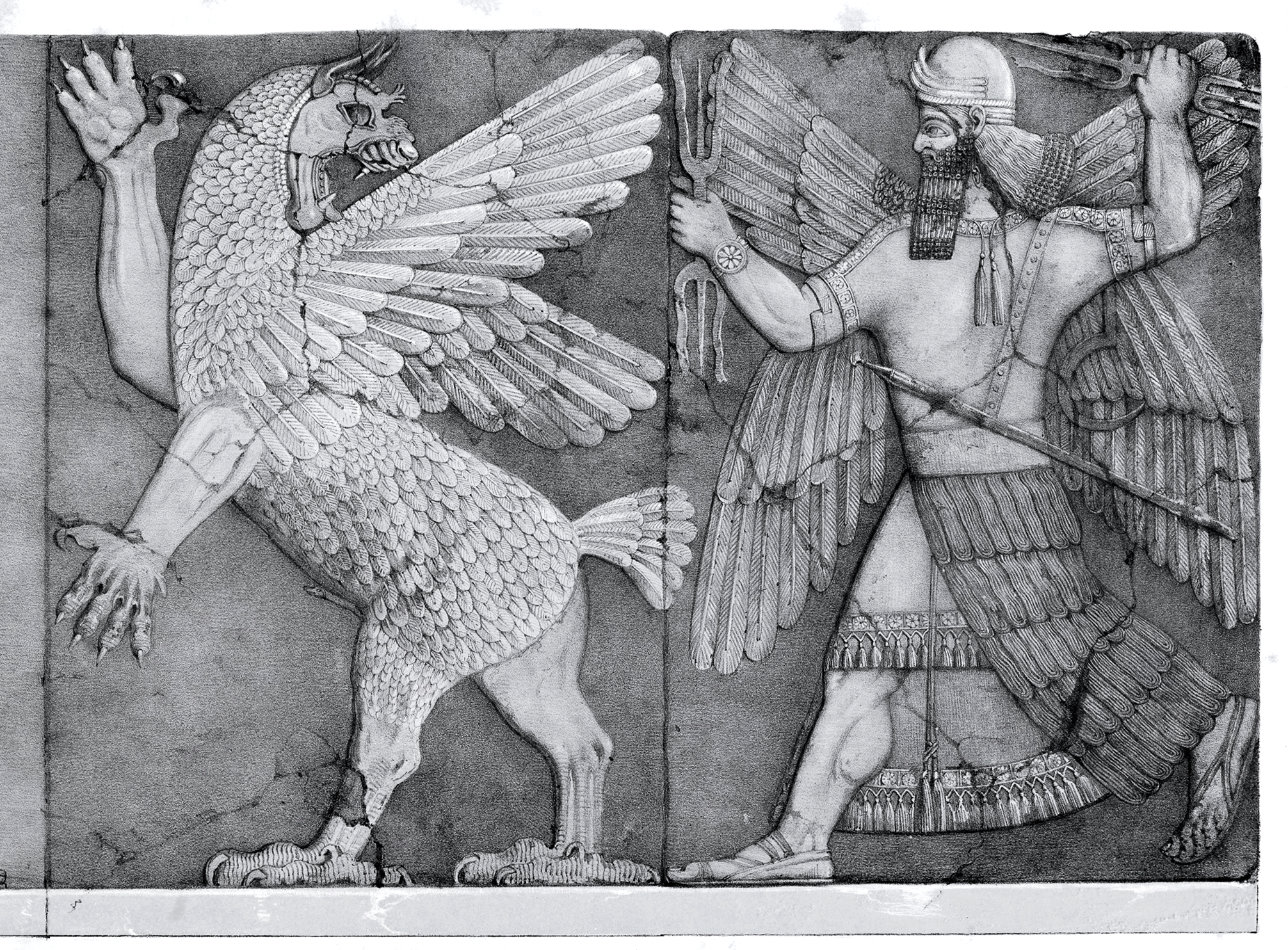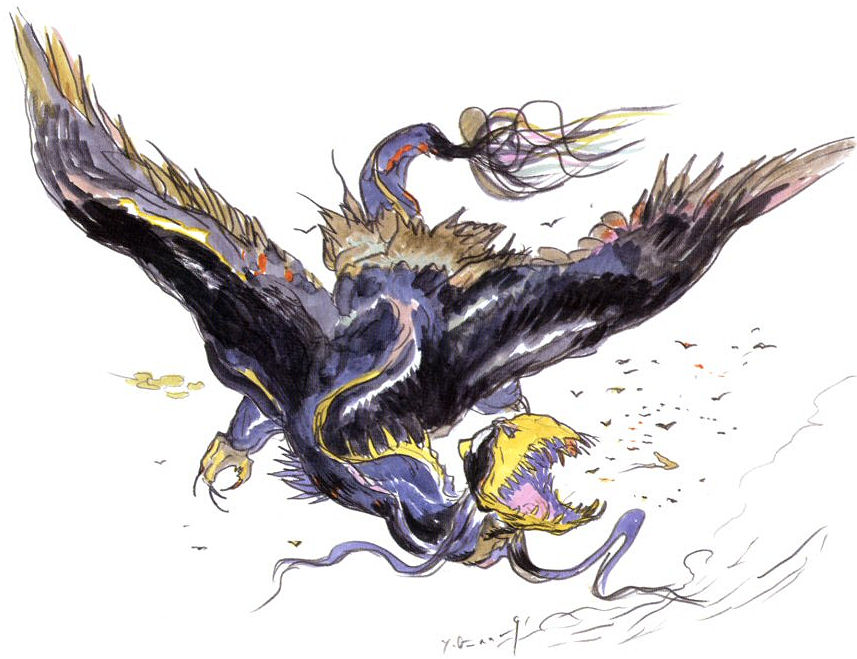Big Birds (original) (raw)

I don’t think I’ve ever written a post about the Simurgh, the giant bird from Persian mythology that I actually first came across in the Xanth series. Pretty much always identified as female, this peacock-like bird is often shown as having the head of a dog and claws of a lion, but with only three on each talon. It is large enough to carry off an elephant or a whale, but quite beneficial, with healing powers.
The Simurgh is old enough to have witnessed the destruction of the world three times (guess she has a place off-world so she doesn’t get destroyed as well), and has gathered more knowledge than any other creature. She perches on top of the Tree of Life, located in the middle of the World Sea.
Some sources give her home as Alburz, the name of an actual Iranian mountain range, although her particular peak is allegedly too steep to climb. The Simurgh’s main job is to distribute seeds throughout the world. Seeds from every kind of plant are left on top of the Tree of Life, and they fall when she lands on the tree. A creature known as the Chamrosh, which has the head of wings of a bird and the body of a dog, then uses its wings to blow the seeds into the sea, where they’re then gathered into a raincloud.
The Chamrosh is also said to protect Persia from invaders, lifting them in its talons. Apparently the Chamrosh eventually fell out of favor, and the Simurgh was usually credited with doing both jobs. Even mythological creatures aren’t immune to downsizing, I suppose. The Simurgh is sometimes said to have a particular enmity with snakes, like the Hindu Garuda, and some myths tell of serpents that repeatedly eat her eggs. The bird has an evil counterpart in the Kamak, which caused drought and devoured people and animals. The heroic monster slayer Kerasp killed Kamak by shooting him with arrows for seven days straight. The most famous legend associated with the Simurgh might be that of Zal, a prince whose father Saam abandoned him as a baby because he had white hair, which the king regarded as a sign of demonic parentage. The Simurgh took Zal and raised him as her own until Saam finally repented.
She gave Zal three feathers to burn in case of danger, and he did so with one of them when his wife Rudaba appeared to be dying in childbirth. The bird taught them how to perform a caesarean section, and both Rudaba and the baby survived, the latter growing up to be the hero Rostam. In the twelfth century, the Sufi poet Attar wrote The Conference of the Birds, about the birds seeking out the Simurgh so that he could choose a king for them. The thirty who survive the journey find only their own reflections, suggesting that they’re all part of the Simurgh.
The Chamrosh replied to this with, “Okay, but I’m still out of a job.” Seriously, this story is partially derived from a pun, in that “Simurgh” can meet “thirty birds,” although that doesn’t seem to have been its original meaning.
The Simurgh is closely associated with giant birds from other cultures. Legends of the Greek phoenix have gotten mixed with those of the Simurgh to the point that the latter is also sometimes said to burn itself up and become reborn after a certain number of years (generally 1700). Anzu, sometimes known simply as Zu, a demon from Mesopotamian mythology associated with storms, is shown as a lion-headed eagle, sort of a reverse griffin.
He’s said to have stolen the tablet that confirms rule of the universe to Enlil, and then to have been killed by either Marduk or Ninurta.
He is also said to have taken over a willow tree Inanna was keeping to make a throne. And the Sumerian hero Lugalbanda is said to have fed Anzu’s chick, in return for which the bird-demon gave him the ability to travel at super speed, so he could be beneficial at times.
Picture by Jane Ray
The bird-monsters Zu and Zuh in the Final Fantasy games are named after Anzu.
Then there’s the Ziz of Hebrew mythology, not to be confused with the Zizzer-Zazzer-Zuzz.
This immortal bird also resembles a griffin, and is said to have had a wingspan large enough to block out the sun.
It is the protector of other birds and a great singer, and the Talmud gives the story of the Ziz warning travelers not to bathe in deep water. The eggs of the Ziz usually slide smoothly into her nest, then hatch without her intervention. Once, however, the Ziz dropped a rotten egg, which ended up smashing 300 cedars and flooding sixty cities. Ziz, like Leviathan, will be food for the faithful at the end of the world. Since the Ziz is capable of procreating, however, this presumably wouldn’t wipe out the species as it would with the Leviathan.
And the Roc of Arabian Nights fame also has similarities to these others, most notably its incredible size and preying on elephants.
This entry was posted in Animals, Authors, Babylonian, Final Fantasy, Greek Mythology, Hinduism, Judaism, Monsters, Mythology, Persian, Piers Anthony, Religion, Semitic, Video Games, Xanth and tagged anzu, arabian nights, birds, chamrosh, demons, enlil, farid ud-din attar, garuda, griffins, inanna, kamak, kerasp, leviathan, lugalbanda, marduk, ninurta, roc, rostam, rudaba, saam, simurgh, talmud, the conference of the birds, tree of life, zal, ziz, zu, zuh. Bookmark the permalink.